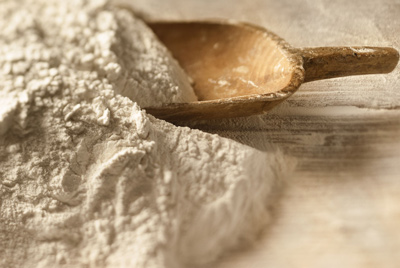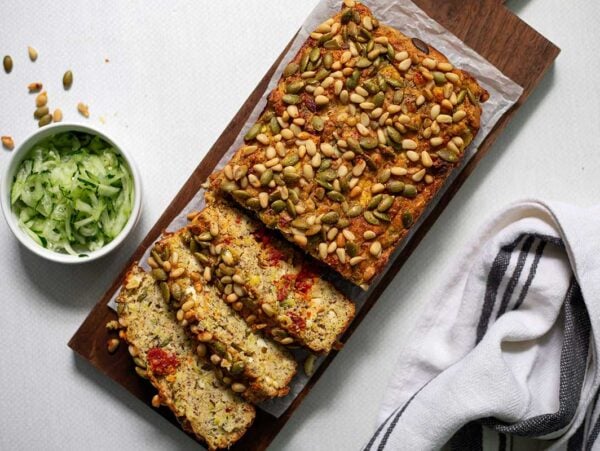How to Make Gluten-Free Braided Challah Bread
Updated Feb 15, 2021, Published Aug 25, 2018
This post contains affiliate links. Please see our disclosure policy.
I tried making gluten-free braided challah bread every which way, and this was one of the last recipes in the book that I felt comfortable finalizing. A water roux [a cooked mixture of flour and fat used as a thickening agent] became essential to making a braided and enriched bread that is both beautiful and moist. This recipe strikes the right balance.
Too many eggs have the paradoxical effect of making bread dry, as the egg white has a tendency to remove moisture from the dough. The bread is dairy, so keep that tidbit in mind if you’re hosting an observant kosher meat meal.
For the best results with this recipe, build your gluten free bread flour using the Make-It-Simpler All-Purpose Gluten-Free Flour recipe below.
Braiding Bread
Regardless of how many strands you are braiding, flour a sheet of unbleached parchment paper and place 10-inch-long stands of dough length-wise on the paper. The strands of dough should be smooth and sprinkled with flour. Pinch all the strands together at one end. Once the bread dough is shaped, you will slide the parchment, along with the dough, onto a baking surface.
To braid a three-strand bread, beginning as close to the sealed edge as possible, cross one outside strand over the center strand. That strand becomes the new center strand. Cross the other outside strand over the new center stand. Repeat process, alternating side, until you reach the end of the stands and pinch the ends together, and press both ends toward the center so that the loaf is thicker in the center.
To braid a four-strand bread, first mentally assign the numbers, 1, 2, 3, and 4 to the four positions the strands occupy on the surface (not to the stands themselves). Beginning as close to the sealed edge as possible, cross the strands over on e another in the following pattern (remember that numbers refer to position, and not actual strands). Repeat the pattern until you reach the end, then pinch the ends together and press both ends toward the center so the loaf is thicker toward the center:
- Strand 4 over strand 2
- Strand 1 over strand 3
- Strand 2 over strand 3
Check out more gluten-free bread recipes!

Gluten-Free Bread Flour
Ingredients
- 100 grams (about 11 ½ tablespoons) all-purpose gluten-free flour (71%)
- 25 grams (about 5 tablespoons) unflavored whey protein isolate (18%)
- 15 grams (about 5 teaspoons) Expandex modified tapioca starch (11%)
Instructions
- Mix all ingredients together in a bowl.
I’ve provided you with two recipes for all-purpose gluten-free flour, either of which will work in building your gluten-free bread flour repertoire as well as any recipe that calls for an “all-purpose gluten-free flour.” This recipe (and all others in Gluten-Free on a Shoestring Bakes Bread) was formulated to work with one of the two blends, both of which necessarily contain a small amount of xanthan gum.
The first, which I dubbed “High-Quality All-Purpose Gluten-Free Flour,” is a copycat of the blend that BetterBatter.org uses in its all-purpose gluten-free flour. I generally prefer it, but it is no doubt more complex than the second blend. You can, of course, simply use Better Batter’s product itself.
The second blend, which I dubbed the “Make-It-Simpler All-Purpose Gluten-Free Flour,” is, well, simpler, with only four components. It is a good substitute for the High-Quality All-Purpose Gluten-Free Flour blend. It does tend, however, to absorb a bit more moisture than the High Quality blend.
A note about component flours: Typically, I insist upon a superfine rice flour for even what I would call “good” results in gluten-free baking, and it certainly is best here as well. However, in any of the bread recipes that call for a long, slow rise in the refrigerator, even a rice flour that is not ground “superfine” will work. As the flour sits in the dough, it absorbs moisture and softens considerably.
Also, please note that although tapioca starch is the same as tapioca flour, potato starch and potato flour are two different ingredients and should not be substituted for each other.

High-Quality All-Purpose Gluten-Free Flour
Ingredients
- 42 grams (about ¼ cup) superfine brown rice flour (30%)
- 42 grams (about ¼ cup) superfine white rice flour (30%)
- 21 grams (about 2 1/3 tablespoons) tapioca starch (15%)
- 21 grams (about 2 1/3 tablespoons) potato starch (15%)
- 7 grams (about 1 ¾ teaspoons) potato flour (5%)
- 4 grams (about 2 teaspoons) xanthan gum (3%)
- 3 grams (about 1 ½ teaspoons) pure powdered pectin (2%)
Instructions
- Combine all ingredients in a bowl.

Make-it-Simpler All-Purpose Gluten-Free Flour
Ingredients
- 90 grams (about 9 tablespoons) superfine white rice flour (64%)
- 31 grams (about 3 ½ tablespoons) potato starch (22%)
- 15 grams (about 5 teaspoons) tapioca starch (11%)
- 4 grams (about 2 teaspoons) xanthan gum (3%)
Instructions
- Mix all ingredients together in a bowl.

Gluten-Free Braided Challah Bread
Ingredients
- 3 tablespoons (25 g) Gluten-Free Bread Flour
- ½ cup water, , at room temperature
- 3 cups (420 g) Gluten-Free Bread Flour, , plus more for sprinkling
- ¼ teaspoon cream of tartar
- 3 tablespoons (36 g) sugar
- 1 2/3 teaspoons (7 g) instant yeast
- 1 teaspoon (6 g) kosher salt
- 2 large eggs plus 1 large egg yolk , at room temperature, beaten
- 5 tablespoons (70 g) unsalted butter,, at room temperature
- ½ cup milk,, at room temperature
- egg wash, (1 large egg, at room temperature, beaten with 1 tablespoon water)
- 1 tablespoon toasted sesame seeds
- 1 tablespoon poppy seeds
Instructions
- To make the water roux, whisk together the flour and water in a small saucepan. Cook over medium-high heat, whisking constantly, until thickened. It is ready when the whisk leaves a visible trail as it moves through the roux. Remove from the heat and allow to cool until no longer hot to the touch.
- To make the dough, place the flour, cream of tartar, sugar, and yeast in the bowl of a stand mixer, and use a handheld whisk to combine well. Add the salt, and whisk to combine. Add the eggs, butter, milk and roux, and mix on low speed with the dough hook until the dry ingredients are incorporated into the wet. Raise the mixer speed to high and mix again for about 5 minutes. The dough will be quite sticky but should be smooth and stretchy. Spray a silicone spatula lightly with cooking oil spray, and scrape down the sides of the bowl.
- Transfer the dough to a lightly oiled bowl or proofing bucket large enough for the dough to rise to double its size, and cover with an oiled piece of plastic wrap (or the oiled top to your proofing bucket). Place the dough in the refrigerator for at least 12 hours and up to 5 days.
- On baking day, line a rimmed baking sheet with unbleached parchment paper and set it aside. Remove the dough from the refrigerator and turn it out onto a lightly floured surface. Knead until smoother.
- Braid the bread. Once it is braided, carefully transfer the braided dough, already on parchment paper, to a rimmed baking sheet. Next brush the top of the dough carefully but liberally with the egg wash. Cover the braided bread with oiled plastic wrap and allow to rise in a warm, draft-free location for 40 minutes. Brush again with the egg wash, sprinkle with sesame seeds and poppy seeds, and allow to continue to rise uncovered until nearly doubled in size (about another 20 minutes).
- Place the bread in the center of a cold oven, and turn the heat to 350° F. Bake for 20 minutes, then turn down the oven temperature to 325° F and bake until the internal temperature of the bread is 185° F on an instant-read thermometer, about another 15 minutes. Allow the bread to cool briefly before serving.
Shop This Post
Excerpt from Gluten-Free on a Shoestring Bakes Bread by Nicole Hunn. Article originally published in Gluten Free & More.















I followed the directions but my dough barely roar at all- should I let it sit outside the fridge as well?
The dough has a couple steps that allow it to rise. Did it rise at all on the first rising step (the bucket in the fridge)? The next rising step is a warm, draft free location for 40 minutes and then again for 20 minutes. Can you tell me if it rose at all during any of those steps? Also, double check the yeast you used and make sure it isn’t expired – sometimes that can play a role.
Is there anything you can do besides the bread flour, I can’t do whey protein isolate or the modified tapioca starch
Hi Lisa, we haven’t tried any variations without the whey protein isolate and tapioca starch.
In her book, she says “The two non-dairy protein powders I recommend are NOW Foods Pea Protein (just read the description to ensure that it is, in fact, a protein isolate) and Growing Naturals Rice Protein Isolate (Original Flavor), both of which are readily available online.” instead of whey protein isolate.
Is the 20 minute bake start at the cold oven or when it reaches 350′
It starts when you put the bread into the cold oven
Is it possible the flour measure is incorrect? My dough was practically liquid after following the recipe to the letter (well… more like ooblek!) and I added another cup of flour before refrigerating. My attempt to knead/handle the dough a day later was a disaster until I worked in probably another half cup to a cup. My dough is rising now but I am worried I’ve invested a lot of time into making a brick. (I am an experienced baker, even with gluten free recipes. I know the dough will be more fragile than wheat dough. But still.) Fingers crossed.
Hi Mir,
Sorry, we’re just seeing this comment now. Did it rise yesterday when you made it? Let us know how it turned out!
It did rise but spread side to side more than up (the braid completely disappeared in the final product). The taste was decent and I will cube it up for French toast, but it definitely didn’t turn out challah-like for me.
I’m sorry to hear that! There are some recipes on our site that I didn’t personally make, and this is one of them, so I can’t give you my first-hand knowledge like I could with my own recipes. This one was published on our site but was originally excerpted from Nicole Hunn’s cookbook. You could reach out to her here: https://glutenfreeonashoestring.com/questions/ or let me know if you’d like me to reach out on your behalf – I just thought it might be easier for you to reach out in case you have follow up questions for her.
Thank you! I may try it again before I reach out to her. There’s always the possibility I just screwed it up somehow. ?
With all due respect, this isn’t Challah, Challah has no Dairy, it is not Brioche.